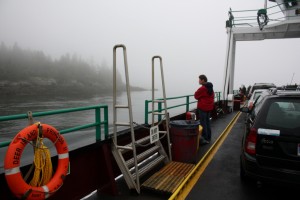 Most Atlantic Canadians have a special relationship to the sea. But it’s the island dwellers in particular who know it intimately. Tides and currents, shores and storms shape the lives of those for whom the sea is as much a highway as it is a buffer from the rest of the world. Starting at the Canada-US border, here’s a quick guide to ten of the best small islands in the Atlantic Provinces.
Most Atlantic Canadians have a special relationship to the sea. But it’s the island dwellers in particular who know it intimately. Tides and currents, shores and storms shape the lives of those for whom the sea is as much a highway as it is a buffer from the rest of the world. Starting at the Canada-US border, here’s a quick guide to ten of the best small islands in the Atlantic Provinces.
1 – Deer Island
For the past 15 summers, Bruce Smith has operated Seascape Kayak Tours from Deer Island just south of St. Andrews, New Brunswick. “It is a unique marine ecosystem just as diverse as the rainforest,” says Bruce. He should know. The other half of the year he takes his award-winning business to Costa Rica. “In the Bay of Fundy we’ve got one of the most diverse marine eco-systems in the world. It’s as special, if not more so, than Costa Rica.” Recently, a New York family paddled with Bruce into a whale feeding frenzy. For two hours, minkes, humpbacks, fin and right whales fed and breached around them.
2 – Campobello Island
 Across a bridge on the eastern most tip of the continental United States or a short ferry ride from Canada’s Deer Island sits Campobello Island. Herring Cove Provincial Park and the adjoining Roosevelt Campobello International Park take up almost half of this 14 kilometre island where, from the age of one, American President, Franklin D. Roosevelt retreated every summer. Today, a large interpretive centre greets 100,000 visitors annually.
Across a bridge on the eastern most tip of the continental United States or a short ferry ride from Canada’s Deer Island sits Campobello Island. Herring Cove Provincial Park and the adjoining Roosevelt Campobello International Park take up almost half of this 14 kilometre island where, from the age of one, American President, Franklin D. Roosevelt retreated every summer. Today, a large interpretive centre greets 100,000 visitors annually.
3 – Grand Manan Island
Ten kilometres into the Bay of Fundy lies Grand Manan. A 1.5 hour ferry ride from Black’s Harbour, this 28×12 km island is home to 2500 people, cliffs full of seabirds – including puffins and bald eagles – a bay full of whales and a fleet of fishing boats. Winslow Homer painted its dramatic landscape, James Audubon sketched many of the 240 bird species and Captain Kidd reputedly buried treasure in a place still called Money Cove.
4- Lameque/Miscou
 For years, Tourism New Brunswick has sold visitors on the province with a shot of the 1856 Miscou Island lighthouse. A national historic site, the road to it is lined in fall with a rich palate of reds, oranges, greens and blues. This mostly French Acadian island and its neighbouring, larger Lameque Island jut into Chaleur Bay off New Brunswick’s north eastern tip. Opportunities for eco-activities like birding, hiking the boardwalks and beachcombing abound. From the outside, the Sainte Cecile Church is pretty, though unremarkable. Inside, the turquoise, lime, yellow and orange ceiling and walls painted by an inspired priest, dazzle.
For years, Tourism New Brunswick has sold visitors on the province with a shot of the 1856 Miscou Island lighthouse. A national historic site, the road to it is lined in fall with a rich palate of reds, oranges, greens and blues. This mostly French Acadian island and its neighbouring, larger Lameque Island jut into Chaleur Bay off New Brunswick’s north eastern tip. Opportunities for eco-activities like birding, hiking the boardwalks and beachcombing abound. From the outside, the Sainte Cecile Church is pretty, though unremarkable. Inside, the turquoise, lime, yellow and orange ceiling and walls painted by an inspired priest, dazzle.
5 – Lennox Island
Tucked behind a barrier sandbar in Malpeque Bay off Prince Edward Island’s north shore is the proud Mi’kmaq nation of Lennox Island. The 400 residents welcome visitors arriving by Highway 163 – dubbed Sweetgrass Trail – with traditional foods at a café and at the annual aboriginal food festival. There’s drumming, dancing and singing at a Pow Wow, history at the interpretive centre, loads of arts and crafts and amble outdoor activities like sea kayaking in the protected waters and walking the trails equipped with signs interpreting 10,000 years of Mi’kmaq history.
6 – Isle Madame
 After the fall of Louisburg in 1758, ten French speaking Acadian families fled to Isle Madame, a 16×11 km island off Cape Breton’s southeast coast. Today, 4300 people call it home, most of them descendants of these original settlers. Traditional Acadian culture thrives at festivals and events and at the Acadian Centre LaPicasse. The LeNoir Forge Museum on the Arichat waterfront tells how the forge outfitted tall ships with chains and anchors.
After the fall of Louisburg in 1758, ten French speaking Acadian families fled to Isle Madame, a 16×11 km island off Cape Breton’s southeast coast. Today, 4300 people call it home, most of them descendants of these original settlers. Traditional Acadian culture thrives at festivals and events and at the Acadian Centre LaPicasse. The LeNoir Forge Museum on the Arichat waterfront tells how the forge outfitted tall ships with chains and anchors.
7 – Big and Little Tancook Islands
Settled partly by German colonists, the Tancooks were once famous for sauerkraut. Fields of cabbage supplied producers and Tancook schooners shipped it in barrels to markets far and wide. Today, 150 permanent residents and as many summer residents live there. Five bucks gets the visitor and a bicycle – by far the best way to explore the islands’ dirt roads – a pleasant 45 minute ferry ride from Chester across the Mahone Bay to the islands. Take home a dozen fresh eggs from Carolyn’s Restaurant next to the wharf on Big Tancook.
8 – Brier Island
 Childhood home to Joshua Slocum – the first person to sail solo around the world – Brier Island is still known for its links to the sea and its world-class wildlife watching – whales on the Bay of Fundy and birds from shore. Flocks of hawks and other usually solitary birds wheel overhead in preparation for fall migration, attracting bird watchers from far and wide. Three lighthouses steer ships clear of the fog-shrouded shores of squared basalt rock, much like those that make up the Giant’s Causeway in Ireland.
Childhood home to Joshua Slocum – the first person to sail solo around the world – Brier Island is still known for its links to the sea and its world-class wildlife watching – whales on the Bay of Fundy and birds from shore. Flocks of hawks and other usually solitary birds wheel overhead in preparation for fall migration, attracting bird watchers from far and wide. Three lighthouses steer ships clear of the fog-shrouded shores of squared basalt rock, much like those that make up the Giant’s Causeway in Ireland.
9 – Fogo and the Change Islands
It’s not just the colourful names of villages — Seldom-Come-By, Joe Batt’s Arm and Eastern Tickle – that placed Fogo Island 22nd on the New York Times’ 41 must-visit destinations for 2011. Amidst the saltbox houses, a charitable foundation has built a series of ultra-modern artist studios on these rugged shores. Though dubbed one of the four corners of the globe by the Flat Earth Society, people still travel from far and wide to attend the annual Brimstone Head Folk Festival in August.
10 – New World Island and the Twillingates
Of the thousands of islands off Newfoundland and Labrador, it’s difficult to name a couple that stand out. Ramea off the south coast and Bell Isle near St. John’s come highly recommended, but the archipelago off the north coast near Fogo – the New World Islands and the Twillingates – offer so much to explore, they can’t be left out. Linked by a series of causeways, it may seem at times that you’re driving out to sea. Hike the “Top of Twillingate Walking Trail” for a view of Iceberg Alley and watch for the famous Fish, Fun and Folk Festival in July.
Photos Credits
All Photographs By Darcy Rhyno – All Rights Reserved


Please Share Your Thoughts - Leave A Comment!